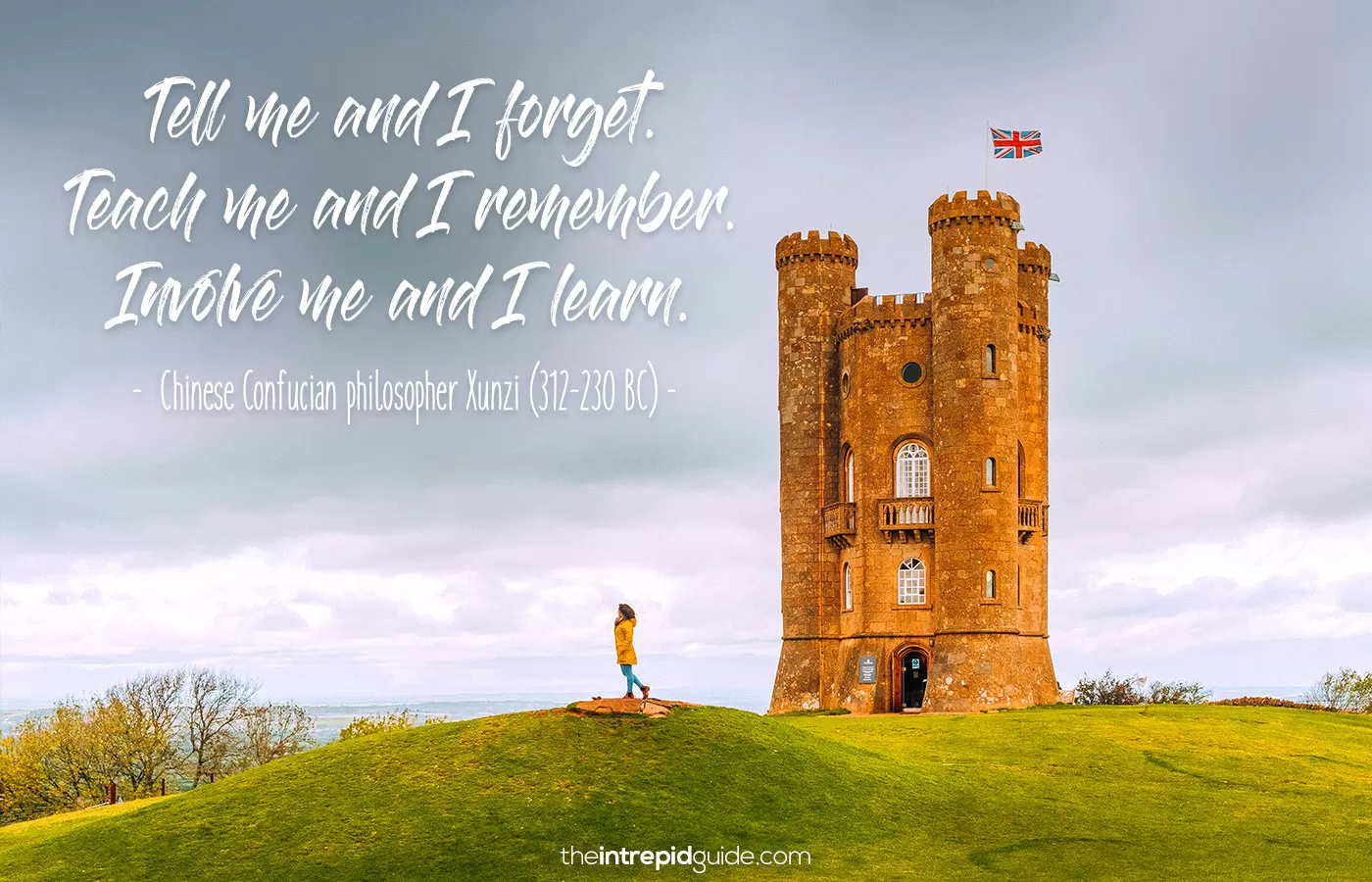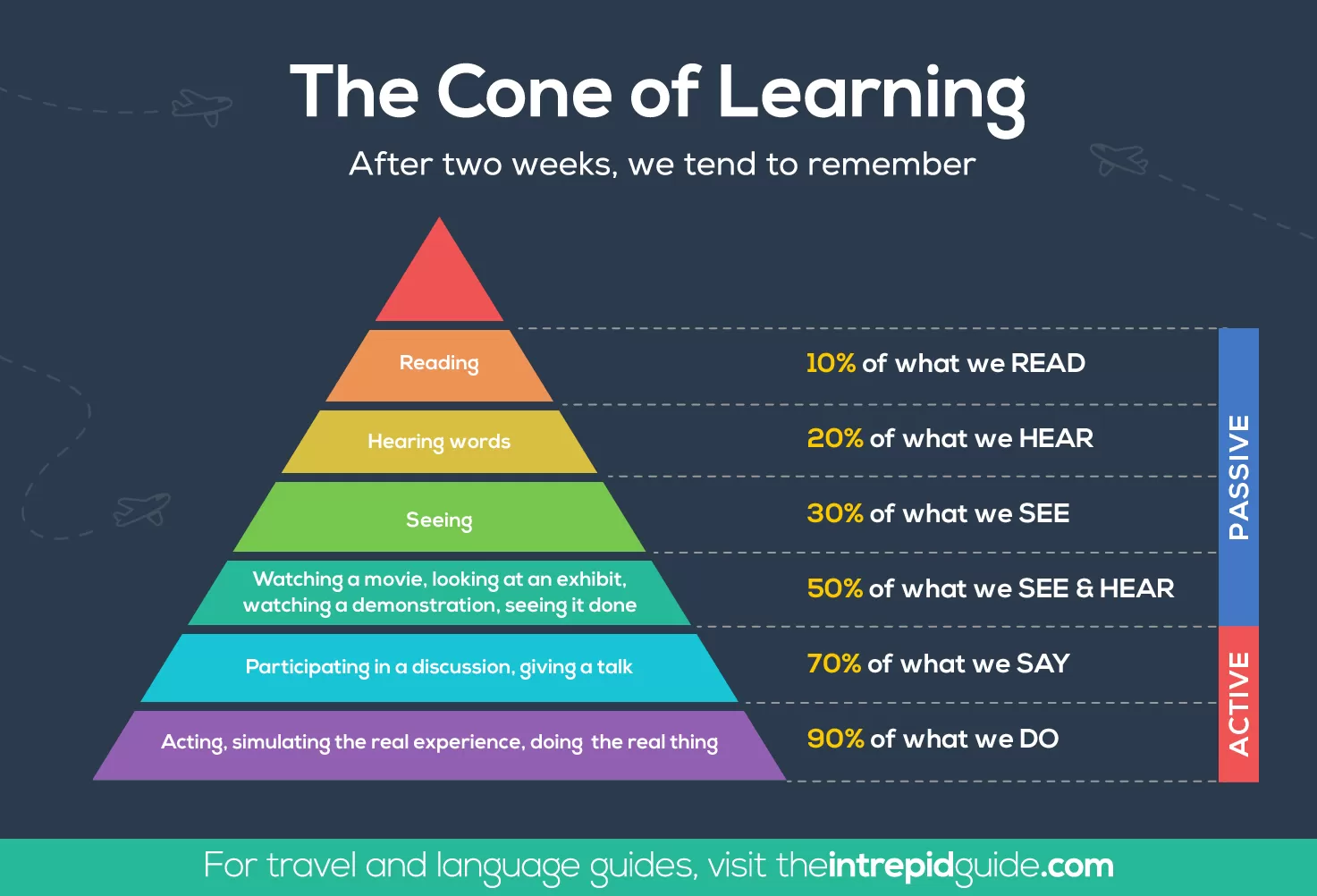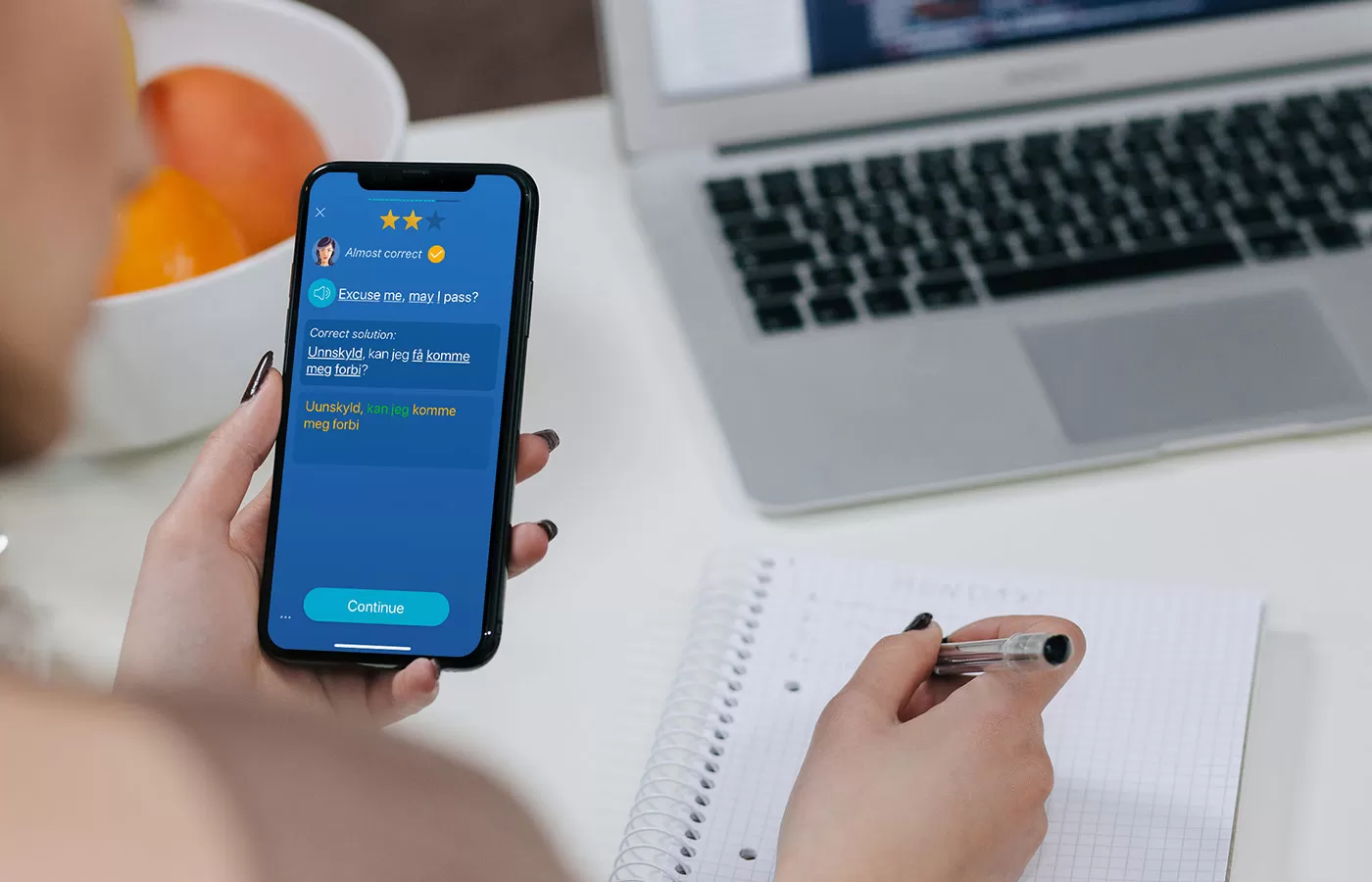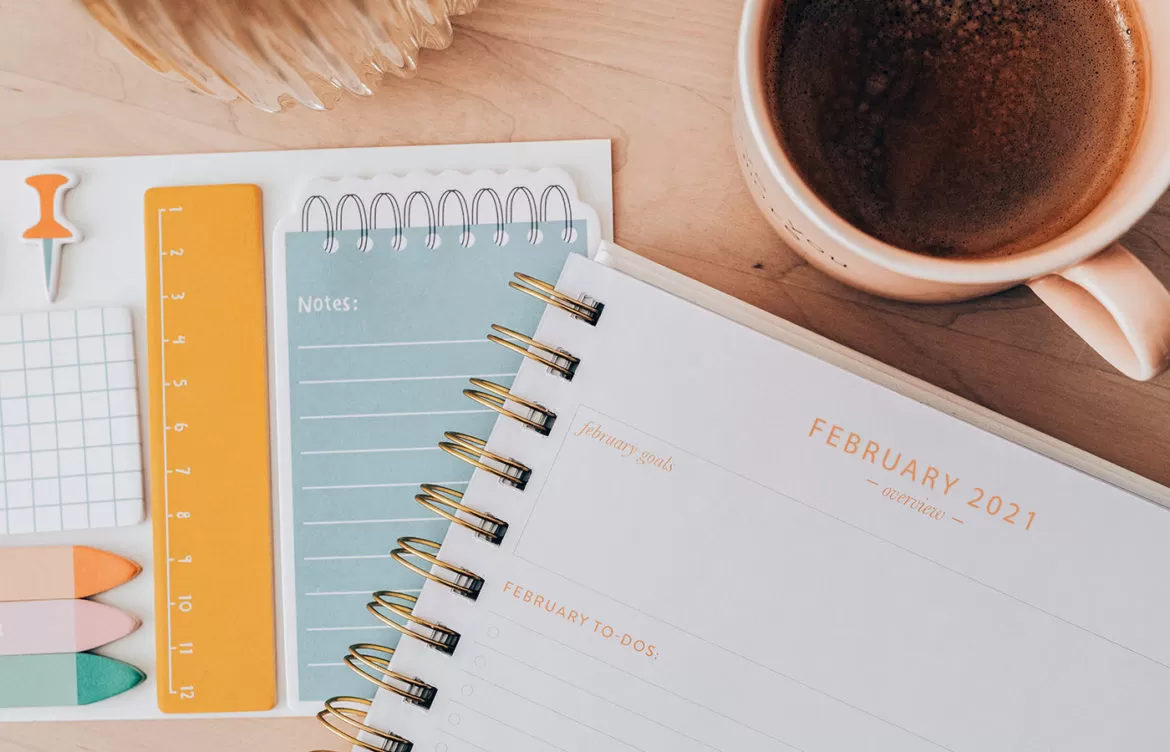Too busy to learn a language? Use my simple 3-step method to unlock untapped time in your busy routine so you can learn languages like crazy, even if you’ve got a crazy life.
I’m busy, you’re busy, we’re all busy. So, how do you learn the foreign language you’ve always dreamed of when you never seem to have the time? It might feel like there just aren’t enough hours in a day but I’ll show you how you can optimise the time you already have so you can finally learn any language. This guide dives into my 3-step method which includes practical tips, strategies, and tools that will kickstart and skyrocket your language learning success.
With so little time left after a typical busy day to dedicate to language learning, it can be discouraging and even disheartening when trying to figure out how you can inject meaningful language learning time into your day.
The keyword here is meaningful.
Let’s take a look at how to learn a language like crazy, even if you have a crazy life!
“Involve me and I learn”

Consider this powerful proverb by the Chinese Confucian philosopher Xunzi (312-230 BC) who wrote in Ruxiao (The Teachings of the Ru), as translated in 1990:
Not having heard something, is not as good as having heard it; having heard it is not as good as having seen it; having seen it is not as good as knowing it; knowing it is not as good as putting it into practice.
Centuries later, this idea was reinterpreted as:
Tell me and I forget. Teach me and I remember. Involve me and I learn”
and was credited to Benjamin Franklin in 1985.
The key to making real progress with your language learning is by being actively involved. Being involved means to be occupied, engrossed or interested in what you’re doing.
So, if we are limited by the time in our day, we need to ensure that what little time we do have for language learning, that we use it wisely and make the most of it. We need to be involved.
The Cone of Learning
An American educator named Edgar Dale further explains this idea further with his ‘Cone of Learning’. Through this, he explains that after the course of two weeks we remember only:
- 10% of what we read,
- 20% of what we hear,
- 30% of what we see,
- 50% of what we hear and see,
- 70% of what we say and write and
- 90% of what we actually participate in.
So, the more you participate, the more you learn and remember in the long run and the faster your progress will be.
This chart explains the Cone of Learning in more detail.

So, what does this mean for you as a busy language learner?
In order to get the most out of the time you do have, you need to focus on language learning methods and strategies that will help you reach your goals sooner. It’s not just about finding the time to learn, it’s what you do with it.
This means focusing on active learning, not passive learning.
What is Passive learning?
Passive language learning is where you are receiving information that someone else produces. Your brain is just absorbing what it hears and sees without you actively engaging with it. You don’t really focus or analyse what’s being said. The information just flows over you.
But therein lies the problem.
For example, if you’re just sitting on your couch with a lap covered in popcorn watching your favourite animation in your target language on Disney+, expecting to absorb the language by osmosis, how much do you think your brain will actually be able to pick up and retain? Unfortunately, the answer is ‘not very much’. Sure you might pick up a new word or a phrase or two, but this won’t move the language learning needle.
Ways to learn languages passively
- Putting post-its around your house with words to learn
- Listening to podcasts, audiobooks, internet radio
- Watching TV shows, movies, documentaries, and YouTube in your target language
- Revising flashcards (both paper ones or in an app)
- Flicking through Duolingo, Mondly or Babbel
- Changing your phone’s language settings
- Just ‘being’ in a place where your target language is spoken but not really engaging with people.
What is Active learning?
Active learning is the polar opposite of passive learning. Active learning is where you take control of your language learning and actively work to reproduce the language. You’re not expecting that your target language will just improve through absorption.
While passive language learning feels easy and familiar and you could do it for hours on end, active learning can feel challenging, difficult, and tiring and will exhaust you after an hour or so of intense concentration.
But this is where progress is made.
If it doesn’t challenge you, it doesn’t change you.
There is, however, the opportunity to turn passive learning into active learning. Let’s revisit the earlier example of passively watching your favourite animation in your target language on Disney+. Can you make this activity active? Absolutely! There are countless ways to do this, but here is one way to do it.
You can watch the movie in short 10-minute chunks. Watch the first 10 minutes, then watch it a second time writing down words or phrases you don’t recognise or understand. Look up these words and write down what they mean. Then watch the segment a third time, paying attention to the new vocabulary. Then write a summary of what’s happened in the film so far using the new vocabulary you’ve learned. For extra points, present this to your class or share it with your italki teacher.
Depending on how much new vocabulary you need to check, this exercise will take you anywhere between 40-90 minutes. You don’t need to do it all at once, you can spread it out through your day.
The important thing to note here is that spending 40-90 minutes focused on 10 minutes of a movie at a time is infinitely more valuable to your learning success than not focusing on anything at all in a movie that lasts for 2 hours!
 Ways to learn languages actively
Ways to learn languages actively
- Write a journal (Start with as little as 1-2 sentences a day)
- Join a language class and contribute to class discussion, ask clarifying questions
- Translate the lyrics of your favourite songs
- Book a conversation lesson on italki – To supplement my own language learning I personally use italki multiple times every week. This is where I get 1-to-1 support and speaking practice with a qualified teacher or community tutor. You can read my full italki review here and book your first italki lesson here.
- Start shadowing, this is the process of listening to a recording and simultaneously echo what you hear in order to improve pronunciation and intonation
- Complete grammar exercises whether from a workbook or online course
- Write a summary of a scene from a TV show, ideas from a documentary, or a scene from a movie using new language used in this content. I personally love to use Disney+ for this as there are so many languages to choose from.
- Prepare a presentation on a topic of your choice and share with your classmates or italki instructor.
- For optimal results, teach someone else. Share what you’ve learned to see if you’ve really understood it. There’s an old Latin proverb by Roman philosopher, Seneca the Younger who said ‘By teaching, we learn’. This is also known as The protégé effect which states that the best way to learn something is to teach it to someone else. To learn more about how memory works, check out my guide on memory hacks to help you remember new vocabulary faster.
Passive Learning vs. Active Learning
 We know that memories are formed most effectively when you force your brain to do something. When you write something down, you actively process information and engage with what you have heard. This makes it far more likely that you’ll remember it.
We know that memories are formed most effectively when you force your brain to do something. When you write something down, you actively process information and engage with what you have heard. This makes it far more likely that you’ll remember it.
On the other hand, by not engaging with this new information, it means that you are far less likely to actually be able to recall it.
Active learning is when you undertake the sorts of activities that after 30 minutes or so, you feel exhausted. But, that’s good! It means it’s working!
If it’s tiring and feels challenging, this is a good sign that you are really pushing yourself. This is where meaningful learning is really happening.
Passive learning, on the other hand, you can do for a long period of time. It’s probably fun or enjoyable, and you don’t feel like it was really ‘work’.
That’s when you know that you haven’t really challenged yourself or learned much during that time.
If you think of the brain as a muscle (albeit a very complex one), if you spend 30 minutes doing a gruelling workout at the gym, it leaves you feeling tired, but you feel great because you’re building muscle and improving your endurance by exertion. You feel a sense of accomplishment.
Compare this with going for a gentle stroll for 30 minutes. This isn’t going to tire you out. It’s good for general health and well-being but it’s not going to dramatically improve your level of fitness. Does it make you feel the same sense of accomplishment as an intense workout? Probably not!
You need to look at language learning the same way.
Remember, if it doesn’t challenge you, it doesn’t change you.
This doesn’t mean passive learning isn’t valuable at all and is a complete waste of time. Every type of learning practice has some value, but passive learning isn’t going to help you reach your language goals when you have limited time.
How to fit language learning into your busy day with ‘dead time’
 Now that we’ve established that active learning is more valuable than passive learning, the next step is to identify the untapped time in your day where you can inject your language learning.
Now that we’ve established that active learning is more valuable than passive learning, the next step is to identify the untapped time in your day where you can inject your language learning.
You’ve probably heard of the term, ‘dead time’. Deadtime is when you’re doing little or no activity. It’s the time we waste every day. Your dead time might be the 40 minutes you spend commuting to work each morning or the 15-minute gap between meetings. Most of us let this time slip through our fingers, and we waste with flicking through our phones, skim social media or playing a highly addictive game. But if you choose to, you can master the art of utilizing dead time. If you do this, you’ll be surprised at the difference it can make to your language skills.
Deadtime can last anywhere from 5 minutes to an hour.
It could also be when you’re doing the dishes, cleaning your house, driving, commuting on public transport, waiting in line, grocery shopping, or even taking a bath or doing your makeup!
It’s in these small pockets of time of your typical busy day that the real opportunity lies. You don’t need to change your schedule or move appointments, you just need to add a language-learning element to your deadtime.
The idea is to use these recurring time blocks to fit in meaningful and active learning time. There’s that word again – meaningful.
However, there is ONE important caveat.
Not all deadtime is created equal.
Some of your dead time will be better suited to passive learning, which, as you know, isn’t going to help you reach your goals. This is when your attention will be divided, and most likely your hands will be engaged too and you won’t be able to fully participate in the learning.
For example, if you listen to a podcast in your target language whilst doing the dishes and you hear a word you don’t understand, what are the chances you’re going to stop, take off your gloves, find your dictionary, phone or laptop and look up the word then add it to your notebook? Pretty slim, right? Well, this is passive learning.
Compare this with listening to the same podcast on your train ride to work. Your hands are free to not just look up the word but to pause the podcast, jot new words down in your notebook, flashcard app or Google docs file for later review. Guess what? You’ve just actively participated in your language learning during your active learning dead time.
This idea can be easily summed up with: Do what you’re doing.
What does this mean?
It means, don’t divide your efforts. By not spreading your attention thin, you’ll reach your goals sooner.
There are countless studies that show that multitasking just doesn’t work (see here, and here). If you really want to learn your target language, then give it the focus 100% it needs.
How to find your dead time
To learn during your deadtime you first need to work out where it occurs. Your task now is to find as many active learning dead time opportunities in your day as possible.
While some of it is obvious, like travel, a lot of dead time occurs without our notice. Small tasks, routine admin, lengthy processes, managing email, attending meetings, responding to colleagues on Slack – while these all count as ‘work’, most of them are hugely unproductive. It’s not easy learning a language with a full-time job, but it is definitely doable. Then there’s the time spent waiting for other things to happen, like boarding a plane, at the doctor’s office, in a queue at the bank, or post office.
It doesn’t matter if you only have a 10-minute time slot once a day or three times a day, or a half-hour time slot before going to bed at night, whatever you can manage is what is going to work for you! Don’t compare yourself with others. No one’s life nor their routine is the same. What works for me, won’t necessarily work for you.
Stay positive and stay focused on what YOU can manage and can stick too. With time, as your routine changes and if language learning becomes a bigger priority, you can create longer active learning sessions in your day.
Remember, small efforts lead to big results.
Shoot for progress, not perfection.
 What to do during your dead time
What to do during your dead time
Now that you’ve identified when your dead time occurs, the next step is deciding what you’re going to do with it. Choosing the right language learning tools, methods, and resources that will work the best for you is key.
To help you with this, you need to know what kind of language learner you are. Are you a visual, aural, verbal, or a kinesthetic learner? Not sure? Take the quiz here.
Once you know your learner type, you can start to gather learning material to store on your phone, keep in your bag or keep handy, so you’ll always have access to the best resources that catered to your individual learning needs.
Here are a few suggested resources for each learner type:
- Visual – Visual learners learn best when they have an image or other visual medium to trigger data in their mind. If you do use audio, such as an Audiobook, accompany it with the e-book version or supporting text covering the same material. When you work alongside a visual medium, you optimize your memorization and comprehension of the material. Use videos, media, cultural immersion.
- Aural – Aural learners are a talented breed — they have a unique ability to capture information by simply hearing it. So, if while listening to a podcast and you experience consistent progress by working through the exercises or material, then stick with that medium. There’s no need to change or modify this type of learning if it already works for you. Use things like audiobooks, podcasts, movies, one-on-one lessons.
- Verbal – Verbal learners learn best when putting pen to paper. Fingers-to-keyboard is great, but physically writing things down is shown to be more effective. One of the most effective ways for a verbal learner to learn a new language is to write down lesson material and repeat it out loud. Use things like one-on-one lessons (I love and use italki), group lessons, or a conversation partner.
- Kinesthetic – Kinesthetic learners learn best with anything that incorporates hand to eye coordination is going to benefit you – electronic games, sign language, acting, even writing. Flashcards and group lessons are great for kinesthetic learners as well. Another great option is to immerse yourself by travelling to a country that speaks your target language for a language holiday.
My 3-step approach: How to learn languages like crazy, even if you have a crazy life!
So there we have it, my 3 step approach to learning languages like crazy even if you have a crazy life!
- Step 1 – Focus only on active learning
- Step 2 – Identify potential active learning dead time in your busy day. Where are there opportunities for you to inject your some study time?
- Step 3 – Take this quiz here and identify what type of language learner you are so you can pick language learning tools, methods, and resources that work best for your learning style.
Key takeaways
- ‘Tell me and I forget, teach me and I may remember, involve me and I learn.’
- If it doesn’t challenge you, it doesn’t change you.
- Identify your dead time
- Identify your learner type (Take the quiz here.)
- Keep relevant learning material on-hand to be ready to use throughout your day
- To learn a foreign language with speed, don’t divide your efforts, multi-tasking doesn’t work
Want to know more about learning languages? Start here!
- 10 Proven Memory Hacks: How to Remember New Vocabulary Faster
- 22 BEST Language Learning Tools & Apps You Should Use
- 6 Language Learning Tips: How to Learn a Language from Home
- 18 Unexpected Advantages & Health Benefits of Learning A Foreign Language
- 44 Best Movies on Disney Plus for Learning Languages
- 7 Reasons Why You Should Go on a Language Holiday
- 203 Most Beautiful Untranslatable Words [The Ultimate List: A-Z]
- What Type of Language Learner Are You? Your 4-Step Personalised Learning Plan
- Essential Travel Phrases: How to be Travel Fluent in 10 Simple Steps
- 10 Pro Tips: How to Learn a Language with a Full-Time Job
- How to Learn Your First Foreign Language in 8 Simple Steps: A Beginner’s Guide
- 13 Ways to Seamlessly Integrate Language Learning into Your Daily Life
- 11 Life-Changing Reasons Why You Should Learn a Language
- 23 Cool Gift for Language Learners They Will Actually Use and Love
- 42 beautiful Inspirational Quotes for Language Learners
- Language learning tips: 11 Polyglots Reveal The Secrets of Their Success
- Top 10 Best Ways to Learn a Language Better and Faster
- How to Learn Italian Before Your Trip
- Language Learning Tips for Anyone Who’s Ever Doubted Themselves
- How a ‘Potato’ improved my French Pronunciation
- How long does it REALLY take to learn a language? [A Practical Guide]
- Memrise vs Duolingo: Which Language App is Best For You?
- Mondly Review: 10 Ways Mondly Drastically Improved My Language Learning
- How Many Languages are there in the World?
- 78 FREE Dictionaries to Learn a Language Fast [Free eBook Download]
- 22 KEY Travel Phrases That Will Transform Your Travels [Free Guide]
Like it? Pin it for later!
![How to learn a language when you're busy [3-Step Method]](https://www.theintrepidguide.com/wp-content/uploads/2020/11/How-to-learn-a-language-when-youre-busy-3-step-Method-1.jpg.webp)
Over to you!
Where have you found deadtime in your daily routine? What type of learner are you? Got a question? Let me know using the comments section below or join me on social media to start a conversation.
Thanks for reading and I hope you enjoyed this post.
Like what you see? Subscribe using the form below to have all of my posts delivered directly to your email.


1 comment
These are really excellent tips Michele. I have struggled to fit my language learning into my busy schedule and it always seems to get left out of my day. I will now use my dead and downtime to continue learning Italian with your course.